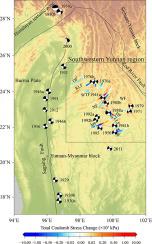当前位置:
X-MOL 学术
›
J. Asian Earth Sci.
›
论文详情
Our official English website, www.x-mol.net, welcomes your
feedback! (Note: you will need to create a separate account there.)
Stress evolution on active faults in the southwestern Yunnan region, southeastern Tibetan Plateau, and implications for seismic hazard
Journal of Asian Earth Sciences ( IF 2.7 ) Pub Date : 2020-09-01 , DOI: 10.1016/j.jseaes.2020.104470 Yujiang Li , Zhigang Shao , Fuqiang Shi , Lianwang Chen
Journal of Asian Earth Sciences ( IF 2.7 ) Pub Date : 2020-09-01 , DOI: 10.1016/j.jseaes.2020.104470 Yujiang Li , Zhigang Shao , Fuqiang Shi , Lianwang Chen

|
Abstract Southwestern Yunnan is expressed as a seismically active region bordering the southeastern Tibetan Plateau. However, the recent seismicity in this region has been relatively quiet. Considering some highly-populated cities nearby and the historical record in this region, understanding the stress changes on the main active faults is crucial for seismic hazard analysis. In this study, we calculated the co- and post-seismic Coulomb failure stress change (ΔCFS) on these faults caused by historical earthquakes in and around the region. Then, by integrating the inter-seismic tectonic loading estimated using a geodynamic model and GPS data, we analyzed the total stress change on all of these faults. The results reveal that the ΔCFS patterns caused by events on different segments of the Sagaing Fault vary; the combined ΔCFS increased on the middle segment of the Longling-Lancang Fault, the Heihe Fault, and the Nantinghe Fault, among which the maximum change reached 3.5 kPa. The great 1950 Assam earthquake in the eastern Himalayan syntax increased the ΔCFS on almost all faults, and the maximum change reached 20 kPa. More importantly, the ΔCFS caused by earthquakes in the southwestern Yunnan region was significantly larger than that caused by earthquakes in the surrounding region because of the geographical proximity. The inter-seismic tectonic stress loading rate reached 2 kPa.yr−1. A significant total stress build-up occurred on five segments distributed among four faults, namely, the Nantinghe Fault, the Longling-Lancang Fault, the Heihe Fault, and the Menglian Fault, making them possible candidates for the next major earthquake in this region.
中文翻译:

滇西南、青藏高原东南部活动断裂应力演化及其对地震危险性的影响
摘要 云南西南部与青藏高原东南部接壤,是一个地震活跃区。然而,该地区最近的地震活动相对平静。考虑到附近一些人口稠密的城市和该地区的历史记录,了解主要活动断层的应力变化对于地震危险性分析至关重要。在这项研究中,我们计算了该地区及其周围历史地震引起的这些断层的同震和震后库仑破坏应力变化 (ΔCFS)。然后,通过整合使用地球动力学模型和 GPS 数据估计的地震间构造载荷,我们分析了所有这些断层的总应力变化。结果表明,实皆断层不同段上的事件引起的ΔCFS模式不同;龙陵-澜沧断裂中段、黑河断裂和南亭河断裂的组合ΔCFS增加,其中最大变化达到3.5 kPa。1950 年喜马拉雅东段阿萨姆大地震使几乎所有断层的 ΔCFS 增加,最大变化达到 20 kPa。更重要的是,由于地理邻近,滇西南地区地震引起的ΔCFS明显大于周边地区地震引起的ΔCFS。震间构造应力加载速率达到2 kPa.yr−1。分布在南亭河断裂、龙陵-澜沧断裂、黑河断裂和孟连断裂等4条断层的5条断层上发生了显着的总应力集聚,使它们成为该地区下一次大地震的候选者。
更新日期:2020-09-01
中文翻译:

滇西南、青藏高原东南部活动断裂应力演化及其对地震危险性的影响
摘要 云南西南部与青藏高原东南部接壤,是一个地震活跃区。然而,该地区最近的地震活动相对平静。考虑到附近一些人口稠密的城市和该地区的历史记录,了解主要活动断层的应力变化对于地震危险性分析至关重要。在这项研究中,我们计算了该地区及其周围历史地震引起的这些断层的同震和震后库仑破坏应力变化 (ΔCFS)。然后,通过整合使用地球动力学模型和 GPS 数据估计的地震间构造载荷,我们分析了所有这些断层的总应力变化。结果表明,实皆断层不同段上的事件引起的ΔCFS模式不同;龙陵-澜沧断裂中段、黑河断裂和南亭河断裂的组合ΔCFS增加,其中最大变化达到3.5 kPa。1950 年喜马拉雅东段阿萨姆大地震使几乎所有断层的 ΔCFS 增加,最大变化达到 20 kPa。更重要的是,由于地理邻近,滇西南地区地震引起的ΔCFS明显大于周边地区地震引起的ΔCFS。震间构造应力加载速率达到2 kPa.yr−1。分布在南亭河断裂、龙陵-澜沧断裂、黑河断裂和孟连断裂等4条断层的5条断层上发生了显着的总应力集聚,使它们成为该地区下一次大地震的候选者。









































 京公网安备 11010802027423号
京公网安备 11010802027423号